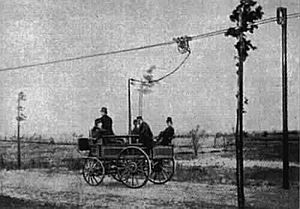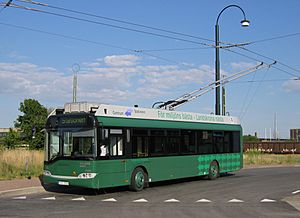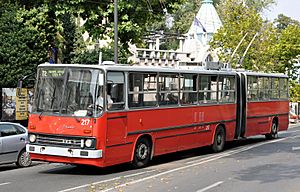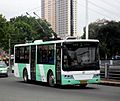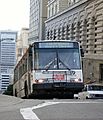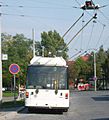Trolleybus facts for kids

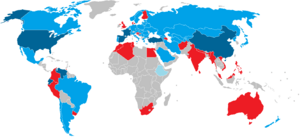
A trolleybus is a special type of bus that runs on electricity. Unlike regular buses that use fuel, trolleybuses get their power from electric wires above the street. They are also known as trolley coaches or trackless trolleys.
These buses have two long poles on their roof, called "trolley poles." These poles connect the bus to the overhead power lines. Electricity flows from the wires, through the poles, and into the bus's electric motors. One wire carries the power, and the other helps the electricity return.
Trolleybuses are often much cleaner and quieter than buses that use diesel. This is because they do not burn fossil fuels. They also do not need tracks like trams, which makes them more flexible. However, trolleybuses usually need to stay connected to their wires, so their travel range is limited compared to normal buses.
Contents
How Trolleybuses Work
Trolleybuses use electricity to move. This power comes from a special system of wires placed high above the roads.
Getting Power from Wires
On top of each trolleybus are two long, thin poles. These are called trolley poles. They touch the overhead electric wires. One wire gives the bus positive electricity, and the other acts as a return path for the negative electricity. This constant connection allows the bus to keep moving.
Why They Are Different
Trolleybuses are unique because they do not have a traditional engine that burns fuel. This means they produce no exhaust fumes, making the air cleaner. They are also very quiet, which is good for cities. Since they do not use tracks, they can steer around obstacles more easily than trams.
Building Trolleybuses
Making trolleybuses can be more expensive than making other types of buses. Because of this, fewer companies build them.
Main Manufacturers
Some of the companies that build trolleybuses include:
Images for kids
-
Trolleybus in Cambridge, Massachusetts.
-
A trolleybus in Qingdao, China
-
A San Francisco Muni trolleybus (ETI 14TrSF) climbing Nob Hill
-
On this articulated Beijing trolleybus, the operator uses ropes to guide the trolley poles to contact the overhead wires.
-
One of the NAW/Hess articulated trolleybuses delivered to Geneva in 1992, which were among the first production-series low-floor trolleybuses
-
A trolleybus in Bradford in 1970. The Bradford Trolleybus system was the last one to operate in the United Kingdom; closing in 1972.
See also
 In Spanish: Trolebús para niños
In Spanish: Trolebús para niños


